William Smallwood was a General in the American Revolutionary War who lived in Maryland as a planter. After the war, he served as the governor of Maryland and was serving as Governor when Maryland ratified the United States Constitution.

Jump to:
William Smallwood Biography: Family
Smallwood was born in 1732 to planter Bayne Smallwood (1711–1768) and Priscilla Heaberd Smallwood (born 1730). He had six siblings:
- Lucy Heabard Smallwood (born c. 1734)
- Elizabeth F. Smallwood (born c. 1736)
- Margaret F. Stoddert (born c. 1738, married Walter Stoddert c. 1760)
- Heabard Smallwood (born c. 1740)
- Priscilla Courts (born c. 1742, married John Courts c. 1760)
- Eleanor Smallwood.
His sister Eleanor and brother Hebard served with him later in the Revolutionary War. His parents sent the boys to England for their education at Eton. His great-grandfather was James Smallwood, who immigrated in 1664 and became a member of the Maryland Assembly in 1692. James' son Bayne (1685–1709) followed him later in the Assembly. Bayne (1711–1775) and his sister Hester were the great-great-grandchildren of Maryland Governor William Stone; Hester (Smallwood) Smith's daughter-in-law Sarah (Butler) Stone was the grandmother of James Butler Bonham and Milledge Luke Bonham. A first cousin of James and Milledge Bonham was Senator Matthew Butler. W
William Smallwood served as an officer during the French and Indian War.
William Smallwood Biography: American Revolution
When the American Revolutionary War began, he was appointed a colonel of the 1st Maryland Regiment in 1776. He led the regiment in the New York and New Jersey campaign, where the regiment served with distinction.
On December 21, 1777, he commanded 1,500 Delaware and Maryland troops at the Continental Army Encampment Site to prevent the occupation of Wilmington by the British and to protect the flour mills on the Brandywine.
For his role at the Battle of White Plains, in which he was twice wounded, Smallwood was promoted to brigadier general. He continued to serve under George Washington in the Philadelphia campaign, where his regiment again distinguished itself at Germantown.
In 1780, he was a part of General Horatio Gates' army that was routed at the Battle of Camden, South Carolina; his brigade was among the formations that held their ground, garnering him a promotion to major general.
Smallwood's accounts of the battle and criticisms of Gates' behavior before and during the battle may have contributed to the Congressional inquiries into the debacle. Opposed to the hiring and promotion of foreigners, Smallwood objected to working under Baron von Steuben.
He spent the remainder of the war in Maryland.
William Smallwood Biography: Later Years
William Smallwood never married but devoted his life to civil service and his plantation. He was the owner of 56 slaves and passed them to his sister Eleanor after his death.
He played an important role in the State of Maryland adopting the United States Constitution
He died in 1792 at his estate in Maryland called Mattawoman.
